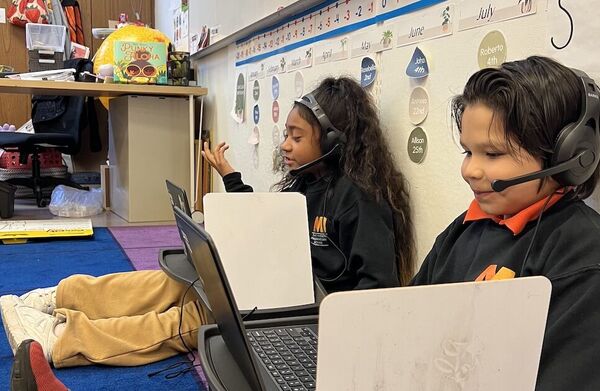Posted on
From tutor to teacher: how Illinois’s state tutoring program is building local pathways into teaching
Categories: Policy and Advocacy, Pathways into Teaching
In a brightly-lit corner of the library at Rochelle Middle School, aspiring math teacher Angie Saldana smiles encouragingly as she guides her tutee to compare different fractions using “greater than,” “less than,” and “equal to” signs.
The low-volume atmosphere and organized displays of books and student artwork around them may convey a typical K-12 setting for after-school tutoring, but for Saldana, this particular environment evokes deeper sentiment: it’s the very school she attended herself as a young student – and the one where she plans to teach after she graduates from Northern Illinois University (NIU).

“All my siblings [and I] have gone through this school,” says the NIU junior and teacher-candidate. “I have strong connections with all the teachers…it’s nice coming back, having that welcome [environment], and having them know me.”
Saldana is one of hundreds of tutors employed through the Illinois Tutoring Initiative (ITI), a statewide high-impact tutoring effort aimed at addressing student learning disruptions impacted by the COVID-19 pandemic. The initiative is organized into six regions, each overseen by a local educator-preparation program, and serves K-12 students of all different backgrounds across 27 school districts in Illinois.
The concept of a statewide system can often connote an impersonal, one-size-fits-all approach, but ITI’s operating structure is intentionally designed to build the capacity of schools and communities to meaningfully engage K-12 students and tutors.
The State Board of Education and Board of Higher Education oversee operations and funding, including identifying districts that meet specific criteria for student need, implementing a data system for tracking student learning progress, managing standards and processes for training tutors, and distributing instructional materials.
Having these logistics run at the state level frees up regional ed-prep programs and partnering K-12 schools to focus most of their energy on facilitating responsive and cohesive student experiences. Importantly, the local schools, regional ed-prep partners, and the state exchange student data to track learning growth. Additionally, many of ITI’s site coordinators are also teachers and staff at the very schools where they run the tutoring program’s day-to-day operations.
“This program is designed with local context in mind,” says Christy Borders, ITI program director. “Every university is different…Every district [has a] voice we listen to. I developed a system focused on the core principles of high-impact tutoring balanced with responsiveness to needs and opportunities of local district partners.”

Image source: Illinois State Board of Education website
In a state that saw 88% of its school districts struggling to find qualified or substitute teachers in 2021, the ITI structure aims to support student learning acceleration in high-need districts and create conditions for a sustainable path to prepare and retain future teachers.
The local focus is particularly aligned with a key trend in the profession: most teachers teach not far from the communities where they grew up. In fact, the median distance between the high school that a teacher attended in 10th grade and that teacher’s place of residence eight years later is just 13 miles. Many aspiring teachers like Saldana not only grew up near the schools where they’re tutoring, but are planning a future teaching in those same schools and communities.
The schools themselves also see these tutors as their future teachers. Melissa Irick, ITI site coordinator and Hiawatha Community Unit School District instructional coach, explains, “Students benefit from more support, and we benefit as a school to try out teacher-candidates. It’s an opportunity for us to get a preview; it’s also wonderful for them to get additional experience that they may not have during a clinical or student teaching experience. You get to dive a lot deeper than you might [while observing] a classroom.”
With the coaching, data-informed assessments, and other supports ITI provides to its tutors to hone their relational and instructional skills, the program especially empowers aspiring teachers to be better prepared for the complex craft of teaching – and is signaling promising early results.

“I’m learning so much…about how to be a teacher,” says Camryn Swann, NIU senior and aspiring middle school humanities teacher. She reflects on how tutoring supports her to be more attuned to her students’ needs and informs her choice of instructional strategies to engage them in affirming learning experiences. As a result, “[My] students are no longer thinking that this subject matter is something they hate and never want to do again. They see they’re progressing, and are not afraid anymore.”
ITI ed-prep programs NIU, Illinois State University, and Southern Illinois University are currently participating in DFI’s Aspiring Teachers as Tutors Network (ATTN) and contributing to a policy framework for scale and sustainability.
Interested in joining the ATTN or learning more about the policy recommendations? Contact Patrick Steck at psteck@deansforimpact.org.
Related Stories:

Blog
Proving the possible: how an Ohio partnership is bringing tutoring to scale
Like many schools across the US impacted by the pandemic, Crim Elementary School in northwest Ohio..
May 24, 2023

Blog
Delivering on the Promise of High-Impact Tutoring
Last summer, President Biden called upon our country to deliver 250,000 tutors...
March 30, 2023

Blog
How a tutoring organization in California builds partnerships and empowers future educators using FWS
Step Up Tutoring partners with 16 colleges and universities to leverage Federal Work-Study.
April 02, 2024






